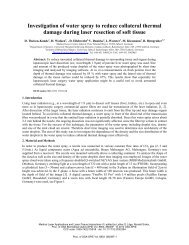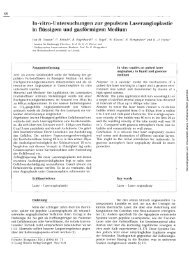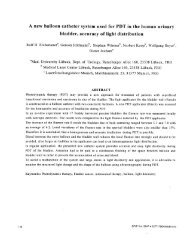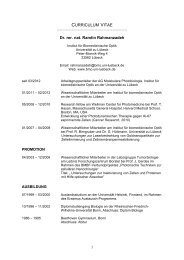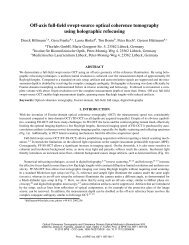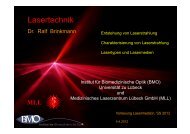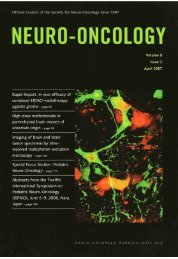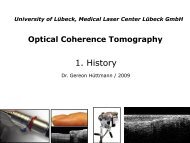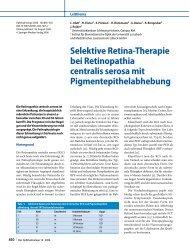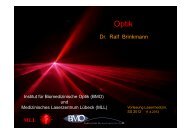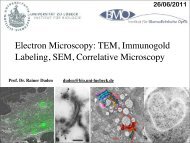Invited p aper Mechanisms of femtosecond laser nanosurgery of ...
Invited p aper Mechanisms of femtosecond laser nanosurgery of ...
Invited p aper Mechanisms of femtosecond laser nanosurgery of ...
You also want an ePaper? Increase the reach of your titles
YUMPU automatically turns print PDFs into web optimized ePapers that Google loves.
1038 Applied Physics B – Lasers and Opticslarger than for NA = 1.3. Therefore, the thermal and chemicaleffects <strong>of</strong> single pulses are sufficiently strong to producea certain amount <strong>of</strong> non-condensable gas by disintegration <strong>of</strong>the biomolecules. Rectified diffusion <strong>of</strong> dissolved air into theoscillating transient bubbles will further contribute to the formation<strong>of</strong> residual, long-lasting bubbles (see Refs. [199, 200]and Ref. [201], Chap. 6).7 Implications for <strong>laser</strong> effects on biological cellsand tissuesTwo parameter regimes have been established for<strong>femtosecond</strong> <strong>laser</strong> <strong>nanosurgery</strong>: one technique uses longpulse series from fs oscillators with repetition rates <strong>of</strong> theorder <strong>of</strong> 80 MHz and pulse energies well below the opticalbreakdown threshold [4, 37, 53, 55, 77, 86, 89, 95, 98]. From40 000 pulses [4] to several million pulses [53, 77] have beenapplied at one specific location to achieve the desired dissectionor membrane permeabilization. The other approachuses amplified pulse series at 1-kHz repetition rate with pulseenergies slightly above the threshold for transient bubble formation[79, 83, 84]. Here the number <strong>of</strong> pulses applied at onelocation varied between 30 [83] and several hundred [79, 84].Based on the discussion <strong>of</strong> the physical effects associatedwith <strong>femtosecond</strong>-<strong>laser</strong>-induced plasma formation in the previoussections, we now proceed to explain the working mechanisms<strong>of</strong> both modalities for cell surgery. For this purpose,the different low-density plasma effects and physical breakdownphenomena are summarized in Fig. 21, together withexperimental damage, transfection, and dissection thresholdson cells. The different effects are scaled by the correspondingvalues <strong>of</strong> free-electron density and irradiance.Chemical cell damage (2) refers to membrane dysfunctionand DNA strand breaks leading to apoptosis-like celldeath observed after scanning irradiation <strong>of</strong> PtK2 cells with800-nm pulses at 80-MHz repetition rate [144]. Chromosomedissection (3) relates to the intranuclear chromosome dissection[4], and (4) to cell transfection by transient membranepermeabilization [53], both performed using 80-MHz pulsetrains from a <strong>femtosecond</strong> oscillator. Mitochondrion ablation(8) refers to the ablation <strong>of</strong> a single mitochondrion ina living cell using 1-kHz pulse trains [85], and axon dissection(9) applies to axotomy in live C. elegans worms carriedout with sequences <strong>of</strong> pulses emitted at 1-kHz repetitionrate from a regenerative amplifier [79]. Points (1), (5), (6)and (7) stand for physical events or threshold criteria. Therespective <strong>laser</strong> parameters and the absolute values <strong>of</strong> irradianceand free-electron density for each point are listedin Table 2.7.1 Femtosecond pulse trains at MHz repetition rateswith energies below the thresholdfor bubble formationThe irradiance threshold (2) for cell death inducedby <strong>laser</strong> pulse series <strong>of</strong> 80-MHz repetition rate scanned overthe entire cell volume (0.067 × I rate ) is lower than the irradiancethreshold for intracellular dissection (3). However,this does not imply that intracellular dissection with 80-MHzpulse series must lead to severe cell damage, because locallyconfined irradiation does not affect cell viability in the sameway as scanning irradiation.The threshold for intranuclear chromosome dissectionwith 80-MHz pulse series (3) is almost four times as largeas the irradiance (1) producing one free electron per pulsein the focal volume (0.15 × I rate vs 0.04 × I rate ). In fact,about 1000 free electrons per pulse are produced with theparameters used for dissection. Therefore, it is very likelyFIGURE 21 Overall view <strong>of</strong> physicalbreakdown phenomena inducedby <strong>femtosecond</strong> <strong>laser</strong> pulses, togetherwith experimental damage,transfection, and dissection thresholdsfor cells. The different effectsare depicted together with the correspondingvalues <strong>of</strong> free-electrondensity and irradiance. The irradiancevalues are normalized to theoptical breakdown threshold I th definedby a critical electron density<strong>of</strong> ϱ cr = 10 21 cm −3 . All data referto plasma formation in water with<strong>femtosecond</strong> pulses <strong>of</strong> about 100-fsduration and 800-nm wavelength;the exact pulse durations are givenin Table 2



